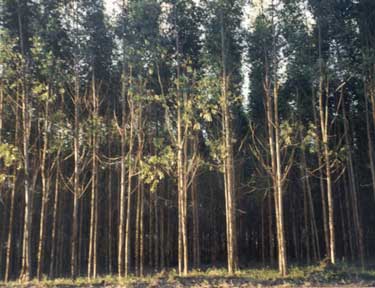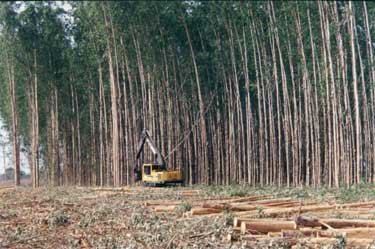Tiempo Climate Cyberlibrary
Plantations Are Not Forests
- Tiempo archive
- Complete issues
- Selected articles
- Cartoons
- Climate treaty
- Latest news
- Secretariat
- National reports
- IPCC
About the Cyberlibrary
The Tiempo Climate Cyberlibrary was developed by Mick Kelly and Sarah Granich on behalf of the Stockholm Environment Institute and the International Institute for Environment and Development, with sponsorship from the Swedish International Development Cooperation Agency.
While every effort is made to ensure that information on this site, and on other sites that are referenced here, is accurate, no liability for loss or damage resulting from use of this information can be accepted.
 |
Ricardo Carrere documents the negative social and environmental impacts of the increased planting of monoculture tree plantations and denounces the mistaken rationale behind this activity. |
|
The author is International Coordinator of the World Rainforest Movement. He is co-author (with Larry Lohmann) of "Pulping the South: Industrial tree plantations and the world paper economy." |
|
Monoculture tree plantations continue spreading throughout the tropics and sub-tropics. The ones we are chiefly concerned about are characterized by being large-scale (tens or hundreds of thousands and even millions of hectares), planted as monocultures and composed of fast-growing species, such as eucalyptus, acacias, gmelinas and pines, some of which are now being cloned for even faster growth.
Field trials are already under way in a number of countries with genetically-modified trees aimed at producing higher yields of a more uniform type of wood to serve the pulp and paper industry's economic interest.
Vast areas of land are already covered by fast-growing tree plantations in Africa, Asia, Latin America, Oceania and even in some European countries (Spain and Portugal) and the southern United States. The Mekong Region countries are no exception. Large-scale plantations were first developed in Thailand, but later spread to Vietnam and are now spreading in Cambodia, Lao PDR and Burma.
|
Defining plantations For mainstream foresters, tree plantations are almost synonymous with forests. The Food and Agriculture Organization's year 2000 definition states that "forest includes natural forests and forest plantations." Most foresters go even further and divide forests into two categories: natural forests and planted forests, which is even worse. Although this implies agreeing that forests and plantations have differences, it also implies that they are essentially the same - both are 'forests'. This apparently simple issue has important implications because it is used as a means of promoting large-scale monocultures, through what the forestry establishment defines as 'reforestation' and 'afforestation' activities which would increase 'forest cover', thus countering deforestation. However, local people are much wiser that the Food and Agriculture Organization and mainstream foresters, because they have suffered the impacts of these so-called planted forests. For them the issue is much more simple - plantations are not forests. |
The obvious question is: what is the reason for so many plantations, composed of the same species, being implemented in so many countries?
The official and corporate answers to that question is usually to present them as a solution to counter deforestation. In all cases they are portrayed as "planted forests" or "forest plantations" that will increase "forest cover," thereby having, so they say, an environmentally positive impact. At the same time, official and corporate publicity stress plantations' capacity to generate employment and wealth at the local level.
None of the above answers are true. Plantations are not forests. On the contrary, they result in negative impacts on soils, water, plants and wildlife. Having none of the positive environmental effects that forests have, plantations can in no way be considered as part of any country's 'forest cover'. Even more, they should be considered as the final blow to the forests they substitute, because they eliminate the possibility of any natural forest regeneration.
|
|
Espirito Santo, Brazil © Ricardo Carrere |
|
Defining plantations... In many places, monoculture tree plantations are defined as 'deserts'. Green deserts, deserts of trees and socioeconomic deserts. Such is the case of Brazil, where a broad group of people and organizations campaigning against eucalyptus plantations have created a network called "Movement Alert Against the Green Desert." The word 'desert' implies a lifeless environment and this is precisely what these plantations are. They provide no food to the local fauna, no space for the local flora and no goods or services to the local people. In a recent visit to a plantation area in Colombia, local peasants took me to a pine plantation and before getting there they told me: "Now you will know what silence means." And they were of course right. Not a single sound was to be heard. It was, in fact, a lifeless and silent desert. However, defining plantations as 'green deserts' has been rightly challenged by a person in South Africa, a country having large desert areas. This woman reacted by saying that "green wastelands" would be more apt than a comparison with deserts, because "there is more biodiversity in a few square metres of the Namib desert than in an entire plantation." But regardless of whether it is or is not correct to call them deserts, the following description of plantations made by a South African local landowner is enlightening: "billions of rows of thirsty pine, gum (eucalyptus) and wattle (acacia) masquerading as 'forests' which cast a sterile blanket over huge areas... to produce pulp, planks and poles for the profit of shareholders." |
Regarding people, large-scale tree plantations result in net employment losses at the local level. The few and low quality jobs they create in no way compensate for the employment and livelihood means they destroy. Large expanses of forest and agricultural land which provide for the subsistence needs of local communities are taken over by plantation companies, resulting in the impoverishment of local communities. The promised wealth never materializes - except in distant cities where company shareholders pocket the resulting profits.
The true reasons for the promotion of these plantations are directly linked to a set of Northern-based interests, ranging from the pulp and paper industry to the appropriation of the atmosphere by Northern polluters.
The powerful pulp and paper industry is at the forefront of the plantation invasion in the South. Its aim is to ensure supply of cheap raw material to allow it to expand its ever increasing paper sales. While using the argument that people need more paper, the industry hides the fact that most of the paper produced is disproportionate to real needs and its consumption is concentrated in the affluent North.
While the average per capita paper consumption in the United States is estimated at 330 kilograms per year, the figure drops to 40 kilograms in Brazil, 38 in South Africa (both large producers and exporters of pulp) and 30 in Thailand. It is clear that it is the industry's and not the peoples' need for pulpwood which is behind the promotion of vast plantations of fast-growing trees in the South.
|
Defining plantations... In the Malaysian state of Sarawak, local people have for years been opposing logging concessions in their territories and have suffered the social and environmental impacts resulting from deforestation and forest degradation. I was, therefore, surprised when a person from Sarawak described eucalyptus and oil palm plantations as being "worse than logging." His explanation couldn't have been clearer. The person said: "logging companies come to our territories, cut the largest trees, take the logs out of the forest and leave. Plantation companies are worse. They come to our territories, cut the best trees, set the rest on fire, plant their own trees and stay!" |
Travelling in the same boat are a numerous set of other interests, such as machinery suppliers, consultancy firms, export-credit agencies, private and multilateral banks, as well as local elites, forestry departments, research institutions and others.
A new set of actors has more recently also become involved in the spread of plantations as a result of a decision by the United Nations Framework Convention on Climate Change that accepted tree plantations as 'carbon sinks'. This needs some explanation.
The North has for years been adding carbon dioxide to the atmosphere through the emissions of its massive use of fossil fuels, creating global climate change. The only sensible solution is to drastically reduce these emissions by changing to non-fossil fuel energy sources such as solar or wind energies, but powerful economic interests, led by the oil and gas industry, oppose such a move. Instead, they put forward the idea of tree 'carbon sinks'.
Trees grow through photosynthesis, which implies that they take carbon dioxide from the air, release the oxygen and convert the carbon into wood. All of which is, of course, true. However, these corporate proponents go on to say that planting many trees will "compensate" carbon dioxide emissions from fossil fuels, which will be "sunk" into the growing trees. This is, of course, untrue.
The reason for this being untrue is simple. Carbon from fossil fuels is not part of the functioning of the biosphere. It is safely stored under the surface of the Earth unless humans extract it, which is what has been happening since the Industrial Revolution. Conversely, trees are part of the functioning of the biosphere and the most they can do is to incorporate the carbon released to the atmosphere by deforestation. One tonne of carbon from fossil fuels is not equivalent to a tonne of carbon stored in trees.
As long as fossil fuels continue being extracted from the sub-soil, the more the carbon pool will increase above ground and climate change will accelerate even further.
However false the solution is, the fact is that it has been adopted and, if implemented on a large scale, will entail more problems to local people in the South.
|
|
Bahia, Brazil © Ricardo Carrere |
|
Defining plantations... South Africans have been quite inventive in providing definitions about plantations. The main reason being that the country has some two million hectares of monoculture tree plantations and almost the same area of land invaded by plantation trees (pines, eucalyptus and acacia). In this country, some people refer to plantations as "green cancer," which provides a good image of how plantations spread and destroy water, soil, wildlife, plants and people's livelihoods, eventually killing everything... as cancer does. |
The second question is: why are these pulp or carbon plantations being implemented in the South, while both the pulp/paper industry and the major polluters are based in the North?
The answer is that the South, particularly regions with tropical and sub-tropical environments, have a number of advantages. Firstly, Southern environments allow for much faster tree growth than in the North. In countries such as Thailand or Brazil, a tree can be harvested for pulp eight years after having been planted, while it can take decades in the North to reach the same size.
Secondly, land is much cheaper in the South and can be leased or bought for substantially less than it would have cost in the North. Thirdly, labour is also cheap and can be made even cheaper through working conditions that would be unthinkable and unacceptable in northern countries. Weak law enforcement regarding the environment and working conditions is also an asset to increased profitability. But an even greater advantage for profitability is through the direct and indirect subsidies which local governments are advised to put in place for the promotion of plantations. This advice of course invariably comes from Northern 'donors', consultants and multilateral institutions. Another added bonus is state repression to local peoples' opposition to plantations or pulp mills.
The end result is the establishment of extensive plantations throughout the South, to either serve as carbon dumps and/or to supply the pulp and paper industry with vast quantities of cheap and homogeneous raw material to feed its pulp mills (increasingly built in the environmentally and socially cheaper South) for the consumption of paper in the North.
In spite of having governments, corporations, 'expert' bodies and mainstream 'science' on their side, plantation promoters still face a major obstacle. That is, local peoples and their allies. This is where the main battle is being fought.
|
Defining plantations... Chile is a South American country where a democratically elected government was overthrown by a military coup in the early 1970s. A ruthless dictatorship ruled the country for almost two decades. During these years the military took over the indigenous Mapuche people's territories in southern Chile and handed them over to plantation companies, which covered them with vast plantations of alien pine trees. It is thus not surprising that I have heard these plantations being described as "planted soldiers" because they are green, planted in straight rows and advancing! Local people hate them as much as they hated the military during the dictatorship they had to endure. That hatred resulted in a strong discussion within the cooperative movement because its international symbol is composed of two pine trees and people didn't want to have pine trees as their symbol. |
Experience has taught local communities that these types of plantations are a major threat to their livelihoods and that they need to oppose them. Alliances are being built at the local, national, regional and international levels and a global movement against plantations has emerged in both South and North. Its message is transparently simple - plantations are not forests! This simple message, though, carries within an implicit message which talks about people's rights, forest conservation, cultural and biological diversity, water, climate and livelihoods, all of which are readily understood by participants in this movement and, in particular, by the local people directly affected by plantations.
The balance is shifting. Opposition is on the rise and plantations are being challenged in an increasing number of countries, ranging from Brazil to South Africa, from Thailand to Chile, from India to Cambodia. Local people are standing up to defend their rights and are joining the global struggle against a plantation model which has already proved to be socially and environmentally negative. Large-scale monoculture tree plantations must, and can, be stopped.
Further information
Ricardo Carrere, International Secretariat, World
Rainforest Movement, Maldonado 1858, CP 11200 Montevideo,
Uruguay. Fax: +598-2-4100985. Email: rcarrere@wrm.org.uy. Web:
www.wrm.org.uy.
On the Web
The book "Pulping the South" is available
on-line. A joint study of the threat
posed by genetically-modified trees by the World
Rainforest Movement and Friends of the Earth
International is also available (from early 2005);
WRM
Bulletin 88 contains related articles.
Acknowledgements
This comment by Ricardo Carrere was presented in the
March-June 2004 edition of Watershed
(Volume 9, No. 3. Watershed is a People's Forum on
Ecology with focus on the nations of Burma, Cambodia, Lao
PDR, Thailand and Vietnam. It is published three times a
year by the "Towards Ecological Recovery and Regional
Alliance" (TERRA). For further information regarding
Watershed and the activities of TERRA contact: TERRA, 409
Soi Rohitsuk, Ratchadapisek 14 Road, Huay Khwang, Bangkok
10320, Thailand. Fax: +66-2-6910714. Email: watershed@terraper.org.
Web: www.terraper.org.
Bright Ideas

General Electric plans to cut solar installation costs by half

Project 90 by 2030 supports South African school children and managers reduce their carbon footprint through its Club programme

Bath & North East Somerset Council in the United Kingdom has installed smart LED carriageway lighting that automatically adjusts to light and traffic levels

The United States National Oceanic and Atmospheric Administration and the American Public Gardens Association are mounting an educational exhibit at Longwood Gardens showing the link between temperature and planting zones

The energy-efficient Crowne Plaza Copenhagen Towers hotel is powered by renewable and sustainable sources, including integrated solar photovoltaics and guest-powered bicycles
El Hierro, one of the Canary Islands, plans to generate 80 per cent of its energy from renewable sources

The green roof on the Remarkables Primary School in New Zealand reduces stormwater runoff, provides insulation and doubles as an outdoor classroom

The Weather Info for All project aims to roll out up to five thousand automatic weather observation stations throughout Africa

SolSource turns its own waste heat into electricity or stores it in thermal fabrics, harnessing the sun's energy for cooking and electricity for low-income families

The Wave House uses vegetation for its architectural and environmental qualities, and especially in terms of thermal insulation

The Mbale compost-processing plant in Uganda produces cheaper fertilizer and reduces greenhouse gas emissions

At Casa Grande, Frito-Lay has reduced energy consumption by nearly a fifth since 2006 by, amongst other things, installing a heat recovery system to preheat cooking oil
Updated: May 15th 2015

